|
 Secure Site
Secure Site
|
 |
Archive for April, 2011
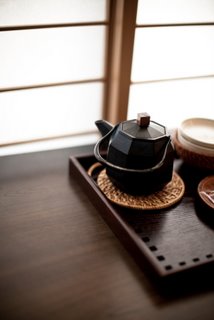 Soothing you senses with a cup of tea From its strong health properties to its millennia-old cultural history, tea provides a rich and nourishing experience in every cup. While all tea is derived from the vibrant leaves of Camellia sinensis, each variety—much like cheese and wine—has its own regional home, processing technique, and unique taste characteristics. As you discover the vast world of tea, you may develop favorite flavors and even regional loyalties (we list a global selection of organic teas below, each rich in antioxidants, amino acids, vitamins, and minerals). The journey starts by creating a personal ritual of preparation and appreciation—soothing your senses along the way.
Black
Formed by withering, rolling, oxidizing, and drying the fresh leaves, black tea today hails largely from the mountainous areas of India, Sri Lanka, and Kenya. Enjoy the touch of honey flavor in Mighty Leaf Tea’s Organic Darjeeling Estate ($12.95, 3 oz).
Oolong
Chinese and Taiwanese tea makers create the characteristically complex flavor of oolong tea—with a bouquet ranging from apricot to spice—by tossing, bruising, and roasting the leaves. For a woody flavor, try Art of Tea’s Iron Goddess of Mercy Roasted ($17, 4 oz).
Green
Fine green teas are the products of spring’s first flush, when warming weather quickly matures dormant nutrients. Minimal processing prevents oxidation, so the leaf retains its natural hue. Numi’s Monkey King Jasmine ($9.75, 4 oz) offers a crisp tea with floral high notes.
White
Slow drying gives white teas their fluffy look, and light oxidation imparts a mellow taste. Experience the delicate White Blueberry by Zhi ($23, 4 oz), brimming with antioxidants.
Pu-erh
Legend has it that the fermented flavor of pu-erh tea was discovered on the ancient Tea Horse Road connecting China and Tibet. Now gaining popularity in the West, pu-erh can be a collector’s item—sometimes aged for decades. Wild Tree Mini Tuo Cha by Arbor Teas ($22.95, 5 oz) boasts a fresh grassy taste with rich depth.
 relax and rejuvenate with a cup of tea
Did You Know? Caffeine occurs naturally in Camellia sinensis (helping the plant ward off insects), but content varies based on factors like regional agricultural conditions, type of leaf, and brewing method. On average, a cup of tea contains one-fourth to one-half the caffeine content of a cup of coffee.
Flavor Unleashed
A soothing cup of tea is the result of a dialogue between water and tea leaves. Asians refer to the process of tea steeping as “the breathing and stretching of the leaves,” according to The Tea Enthusiast’s Handbook by Mary Lou and Robert J. Heiss.
Unglazed teapots and ceramic cups with covers called gaiwans are the ideal vessels to unfurl flavor, says Mary Lou. If you’re at the office or prefer one serving, single-cup mesh filters or paper tea sacks give leaves more space to open and release flavor than do tea balls. With simple equipment, the tea cup can become your witness to a delicious conversation.
adapted from Yoga Internation by Janet Webb Lee — an acupuncturist who also studied yoga and ayurveda extensively. She practices at the Center for Health and Well Being in San Diego, CA.
 Timers with chime, perfect for timing tea
Now & Zen
1638 Pearl Street
Boulder, CO 80302
(800) 779-6383
Posted in Meditation Tools, teahouse
 how to design a sacred space Create a personal meditation space that inspires your practice and invokes your higher self.
If you’re a gardener, you know the value of choosing an ideal site and preparing quality soil for nurturing healthy plants. The same is true for tending to your inner growth: when you devote a nook in your home to your practice and sow it with your higher intentions, you create the right conditions for your spiritual life to thrive.
A dedicated space collects and focuses your energy, removes uncertainty about where to practice, and, through habit and association, helps the mind move inward more quickly and deeply. Much like an encounter with the refrigerator conjures thoughts of food, and a glance at the couch invites a comfortable sprawl, catching sight of your meditation seat in a sanctified space will evoke your deepest yearnings and inspire you to do your practice.
Choose a place that can become a sanctuary—a quiet, private space protected from outside distractions and out of public view. You may be fortunate enough to designate an entire room, but a corner in your bedroom will suffice.
You’ll need a meditation seat—traditionally known as your asana—which may be a neatly folded blanket topped by a cushion for support, or even a chair or bench. Keep any additional props needed to support a comfortable sitting posture nearby, as well as your mala, shawl, or journal; but otherwise keep the space uncluttered and scrupulously clean.
A simple altar will serve as the heart of your space, calling you to your practice by providing inspiration and focus. An altar is an acknowledgement of the deeper essence of life and a bridge to the unseen—a link between our life in the world of elements and the subtle world. All altars, even public ones, serve to remind us of meaning and purpose in life, and connect us to inner strength and guidance. In religious or ritual settings, an altar is the locus for offerings made to ancestors or deities. In the context of yoga meditation, an altar inspires an offering of inner resources rather than outward ceremony or ritual, so simplicity is key.
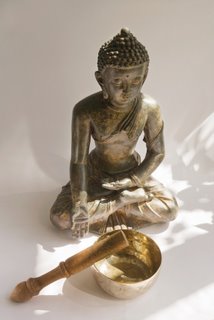 Carved Wooden Thai Buddha with Singing Bowl Try a small low table or a small chest of drawers at eye level, with a tasteful and simple covering. The objects you place upon your altar give focus, substance, and energy to your highest intentions. Traditionally, a flame (from a candle or a ghee lamp), water, flowers, fruit, and incense are offered on an altar to represent the gifts of the world given to us through the five elements. Often, these are joined by objects from a pilgrimage—a stone, sanctified water, or a sacred representation (such as a picture of Our Lady of Guadalupe or a carving of Lord Ganesha). The objects themselves are not as important as whether the altar uplifts the mind and touches the heart.
By creating a sacred space that encourages you to cultivate and nurture a devoted practice, you are one step closer to tasting the fruits of yoga—unconditional well-being and pure awareness.
adapted from Yoga International by, Sandra Anderson / co-author of Yoga: Mastering the Basics and has taught yoga and meditation for over 25 years.
Use our unique “Zen Clock” which functions as a Yoga & Meditation Timer. It features a long-resonating acoustic chime that brings your meditation or yoga session to a gradual close, preserving the environment of stillness while also acting as an effective time signal. Our Yoga Timer & Clock can be programmed to chime at the end of the meditation or yoga session or periodically throughout the session as a kind of sonic yantra. The beauty and functionality of the Zen Clock/Timer makes it a meditation tool that can actually help you “make time” for meditation in your life. Bring yourself back to balance.
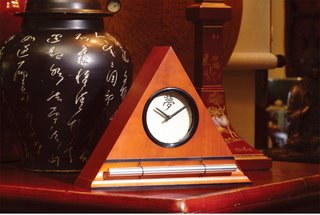 zen alarm clocks and chimes for a gentle awakening Now & Zen – The Zen Meditation Timer Store
1638 Pearl Street
Boulder, CO 80302
(800) 779-6383
Posted in Chime Alarm Clocks, Well-being, Zen Timers
 establish a sleep schedule to cure depression Sleep problems go hand-in-hand with depression. Some people who have depression want to sleep constantly, while others suffer from insomnia. While the relationship between sleep and depression is still being explored, studies have shown that sleep problems often precede depression, and scientists believe that sleep deprivation can also worsen depression.
The American Academy of Sleep Medicine recommends getting an average of 7 to 8 hours of sleep each night—a number that most Americans fall short of. Too often sleep is seen as a luxury instead of a necessity in our culture. Whether we’re working late, staying out with friends or just catching a late night TV show, most of us don’t get enough rest each night. And as sleep affects more than just our mental health—sleep deprivation has been linked to greater risk for cancer, diabetes and heart disease—it would be wise to give up the slogan “I’ll sleep when I’m dead” and change those habits now.
adapted from Natural Home Magazine, December 2010 by Susan Melgren
 Natural Awakening Alarm Clock with Chime
Now & Zen
1638 Pearl Street
Boulder, CO 80302
(800) 779-6383
Posted in Uncategorized
 the link between sleeping and weight Not sleeping enough can do more than make you groggy the next day. It can also take a serious toll on your health—starting with your weight.
In the past several years, medical experts have confirmed a link between lack of sleep and weight problems, and a new study from the University of Chicago and the University of Wisconsin-Madison confirms this. Researchers conducted their study on two groups of overweight people. The first group slept for only five and a half hours each night, and the second group slept for eight and a half hours each night. The study found that while both groups lost weight, those who slept longer burned more fat, while those who slept less burned more muscle mass.
In an interview with NPR, sleep medicine expert Dr. Michael Lacey of the Atlanta Sleep Medicine Clinic explained that lack of sleep not only decreases metabolism, but also interferes with the body’s natural production of the hormones ghrelin and leptin, which regulate appetite and satiation. Too little sleep causes the body to produce too much ghrelin, which makes you feel hungry, and not enough leptin, which makes you feel satiated or full. Staying awake longer than you should will make you feel hungry when you’re really not, and will lead you to eat at times you normally wouldn’t. The longer you stay awake, the more tempted you’ll be to snack, too. To make matters worse, most people staying awake too long reach for high-carb or sugary foods, which they’re unlikely to burn off in the wee hours of the night.
Getting enough sleep will help your body burn fat and regulate weight. But how much is the right amount to get? Most sleep experts pinpoint seven to seven and a half hours as the magic sleep number. Sleep fewer than seven hours and you run the risk of fatigue and weight problems. Sleep too much and you put yourself at risk for cardiovascular disease.
adapted from Natural Home Magazine, October 2010 by Susan Melgren
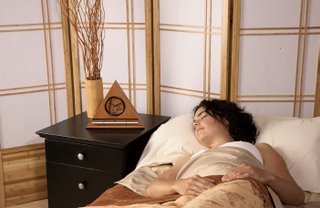 gentle alarm clock, for a slow wake-up
Now & Zen
1638 Pearl Street
Boulder, CO 80302
(800) 779-6383
Posted in Chime Alarm Clocks, sleep, Sleep Habits, wake up alarm clock, Well-being, Zen Alarm Clock
 progressive muscle relaxation Get into a comfortable position, either sitting or lying down.
Raise your eyebrows as high as you can, then hold the tension for a moment. Relax, allowing the tension to release.
Squeeze your eyes shut as tight as possible, hold the tension, then relax your eyelids.
Moving down your entire body, tense and relax your muscles, one body part at a time. After your eyes, focus on your jaw, then your chin (creating tension by moving it toward your chest), your hands (squeezing each into a fist), your stomach, your legs, and your feet.
After you’ve reached your feet, spend a few minutes breathing deeply and focusing on how relaxed your body feels. Stretch, and get up when you feel ready.
adapted from Body + Soul, January/February 2010
 digital timers for meditation and yoga with chime Now & Zen
1638 Pearl Street
Boulder, CO 80302
(800) 779-6383
Posted in Meditation Timers, Meditation Tools, mindfulness practice
 meditation outdoors
- Find a park, forest, beach, nature preserve, or reservoir.
- If possible, remove your shoes. Walk around for a few minutes until you come to a place where you feel like pausing.
- Stand still for a moment and take in the natural elements around you. Take 10 deep breaths, inhaling through your nose and exhaling through your mouth.
- Notice how your body feels. What feels tight, tired, achy? What parts feel loose and easy? Take five more breaths, directing the breath to the tight places and relieving the tension as you exhale.
- Begin walking again, for as long as you’d like. Allow yourself to be completely absorbed by nature.
- When you are done, notice how you feel, such as whether your breath is easier, your body feels more relaxed, and your heart is more connected to what’s around you.
adapted from Body + Soul, January/February 2010
 meditation tools and timers with chimes
Now & Zen
1638 Pearl Street
Boulder, CO 80302
(800) 779-6383
Posted in Well-being
 yoga “While yoga can certainly help you recover from injury, like any physical activity, it can also lead to one if you’re not careful. According to the U.S. Consumer Product Safety Commission, there were an estimated 5,000 reported injuries due to yoga practice in 2005. “Distinguishing pain from a really good stretch takes a little practice,” explains Baxter Bell, M.D., a Petaluma, California-based yoga teacher, physician, and medical acupuncturist. He offers these tips to reduce your risk of getting hurt.
1. Talk to your teacher before class. Your instructor can help you modify your poses to accommodate an injury, but only if he or she knows you have one. If your instructor doesn’t have good advice on how to approach your special need, consider looking for another instructor.
2. Don’t exceed your limits. Beginning students, especially, tend to push a little too hard.
3. Pay attention to hot spots. The knees, lower back, sacrum, wrists, and shoulders — observe all of these areas as you practice.
4. Use props. In a pose like Triangle, a block can help you come out of the depth of the pose.
5. Talk to your teacher after class. If something hurts as a result of your practice, let your teacher know so that the next class will be better.
6. Take post-practice care. Ice any sore spots or consider taking a natural anti-inflammatory.
adapted from Body + Soul, October 2007
 Zen Clock with Gentle Chime for Yoga and Meditation
Now & Zen
1638 Pearl Street
Boulder, CO 80302
(800) 779-6383
Posted in Well-being, yoga, Yoga Timer, Yoga Timers by Now & Zen
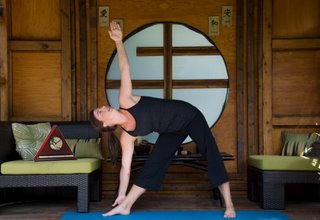 yoga tips from the masters New to yoga? Notable yoga experts offer these 5 tips.
1. “Along with your yoga mat and your towel, bring a sense of humor to class. Students who get hung up on doing everything ‘perfectly’ are less likely to come back.”
–Seane Corn, creator of the Vinyasa Flow Yoga DVD series and national yoga ambassador for YouthAIDS
2. “Don’t force your way into yoga. Adapt your movements to accommodate your level of strength and stamina, so that you avoid injury and feel comfortable in every pose.”
–Baron Baptiste, founder of Baptiste Power Vinyasa Yoga
3. “Watch out for what I call ‘self mutilation’ — spending your time talking to yourself about what you can’t do. This will make your practice dismal. The more you stay connected to feeling the pose — to breathing into the pose — the better your experience will be.”
–Ana Forrest, founder of Forrest Yoga
4. “To jump-start your practice, go on a yoga retreat. By temporarily shelving all the distractions in your normal life, you’ll learn enough in just two or three days to make a big difference in your weekly yoga class experience.”
–Richard Faulds, former president of Kripalu
5. “When you get to class, keep an open mind. Tune in to your own infinite possibilities. And drink water.”
–Guruatma Singh Khalsa, co-owner of Franklin Yoga and yoga instructor for 32 years
adapted from Body + Soul, by Abbie Barrett
Use our unique “Zen Clock” which functions as a Yoga Timer. It features a long-resonating acoustic chime that brings your meditation or yoga session to a gradual close, preserving the environment of stillness while also acting as an effective time signal. Our Yoga Timer & Clock can be programmed to chime at the end of the meditation or yoga session or periodically throughout the session as a kind of sonic yantra. The beauty and functionality of the Zen Clock/Timer makes it a meditation tool that can actually help you “make time” for meditation in your life. Bring yourself back to balance.
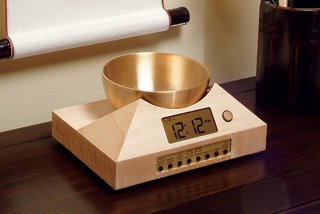 yoga tools for wellness Now & Zen – The Yoga Timer Store
1638 Pearl Street
Boulder, CO 80302
(800) 779-6383
Posted in Well-being, yoga, Yoga Timer
 meditation requires consistency Meditation requires consistency, being there whether you want to or not. You’ll have days when you just don’t feel like it, but that’s precisely the time you should get on the cushion to observe and work with your resistance, says Summers. “There are great lessons within the resistance.” Meditating at the same time every day may also help solidify your practice.
adapted from Body + Soul
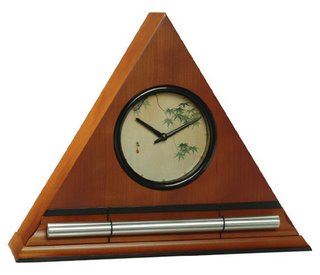 meditation and yoga timers and alarm clocks for a gentle wake up
Now & Zen
1638 Pearl Street
Boulder, CO 80302
(800) 779-6383
Posted in Meditation Timers, Meditation Tools, mindfulness practice
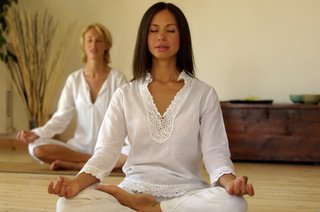 practice mindfulness with other people Sitting with other meditators at least once a week can fuel your practice. “There is something supportive about the group dynamic that helps to hold you in the environment,” says Summers.
Here and there, I found the elusive present, listening to my breath as if it were the only thing that mattered.
adapted from Body + Soul
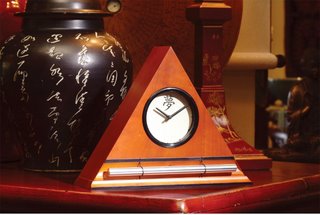 clocks with gentle chimes for a peaceful awakening
Now & Zen
1638 Pearl Street
Boulder, CO 80302
(800) 779-6383
Posted in Meditation Timers, Meditation Tools, mindfulness practice
« Previous Entries
Next Page »
|
|
|
|